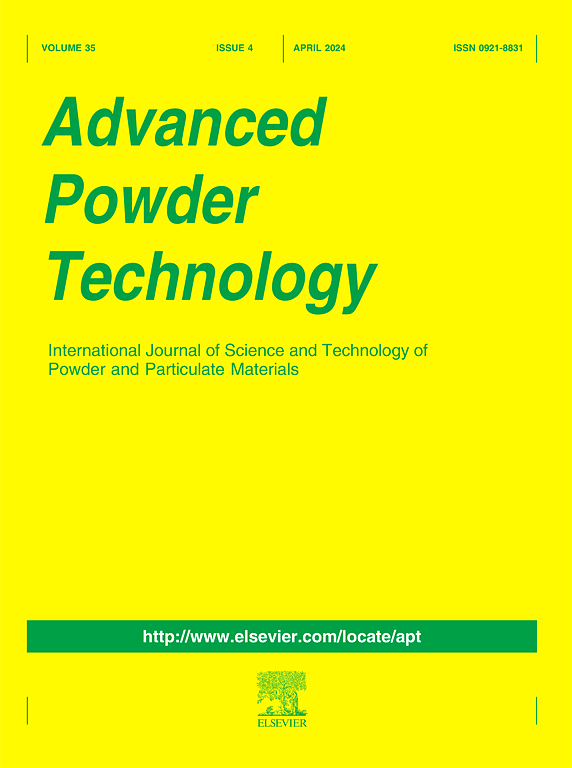阴离子聚丙烯酰胺制备黄铜矿聚集体的形成和破坏:聚合物分子量和剪切条件的影响
IF 4.2
2区 工程技术
Q2 ENGINEERING, CHEMICAL
引用次数: 0
摘要
絮凝浮选是细颗粒处理和回收的重要工艺。在典型絮凝-浮选条件下,研究了聚合物分子量(MW)和剪切环境对阴离子聚丙烯酰胺(APAM)处理的细粒黄铜矿颗粒聚集行为的影响。利用图像衍生弦长分布(ID-CLD)获得高分辨率的原位图像来测量骨料大小。分析了聚合物分子量与剪切力之间的关系,以及聚合体的形成和断裂动力学、断裂可逆性和聚合体的再生。结果表明,聚集体通常在加入聚合物后1分钟左右达到最大尺寸,并随着时间的推移而破裂。更高分子量的聚合物产生更大的聚集体,可以更好地承受破碎效应。较低的剪切速率促进了絮凝体的生长,而较高的剪切速率则促进了相对受阻的骨料生长和颗粒破碎。剪切破碎过程对黄铜矿颗粒来说基本上是不可逆的,在剪切还原后会有少量的团聚体再生长。这些发现为聚合物特性和剪切条件在控制聚合体大小和完整性中的作用提供了关键见解,这对于优化分离过程和工业装置中的聚合性能至关重要。本文章由计算机程序翻译,如有差异,请以英文原文为准。

Formation and breakage of chalcopyrite aggregates produced by anionic polyacrylamides: Influence of polymer molecular weight and shear conditions
Flocculation-flotation is an important process for the treatment and recovery of fine particles. This study investigates the influence of polymer molecular weight (MW) and shear environment on the aggregation behaviour of fine chalcopyrite particles treated with anionic polyacrylamides (APAM), under a typical range of flocculation-flotation conditions. High-resolution in-situ images were obtained to measure aggregate size using Image Derived Chord Length Distributions (ID-CLD). The relationship between polymer MW and shear-induced forces was analysed along with aggregate formation and breakage kinetics, breakage reversibility and aggregate regrowth. The results indicate that the aggregates typically reached maximum sizes about 1 min after polymer addition and break over time. Higher MW polymers produced larger aggregates that could better withstand breakage effects. Lower shear rates enhanced floc growth, whereas higher shear rates promoted comparatively hindered aggregate growth and increased particle breakage. The shear-induced breakage process was found to be mostly irreversible for the chalcopyrite particles, with minor aggregate regrowth following subsequent shear reduction. These findings provide key insights into the role of polymer characteristics and shear conditions in controlling the size and integrity of aggregates, which is essential for optimising aggregation performance in separation processes and industrial plants.
求助全文
通过发布文献求助,成功后即可免费获取论文全文。
去求助
来源期刊

Advanced Powder Technology
工程技术-工程:化工
CiteScore
9.50
自引率
7.70%
发文量
424
审稿时长
55 days
期刊介绍:
The aim of Advanced Powder Technology is to meet the demand for an international journal that integrates all aspects of science and technology research on powder and particulate materials. The journal fulfills this purpose by publishing original research papers, rapid communications, reviews, and translated articles by prominent researchers worldwide.
The editorial work of Advanced Powder Technology, which was founded as the International Journal of the Society of Powder Technology, Japan, is now shared by distinguished board members, who operate in a unique framework designed to respond to the increasing global demand for articles on not only powder and particles, but also on various materials produced from them.
Advanced Powder Technology covers various areas, but a discussion of powder and particles is required in articles. Topics include: Production of powder and particulate materials in gases and liquids(nanoparticles, fine ceramics, pharmaceuticals, novel functional materials, etc.); Aerosol and colloidal processing; Powder and particle characterization; Dynamics and phenomena; Calculation and simulation (CFD, DEM, Monte Carlo method, population balance, etc.); Measurement and control of powder processes; Particle modification; Comminution; Powder handling and operations (storage, transport, granulation, separation, fluidization, etc.)
 求助内容:
求助内容: 应助结果提醒方式:
应助结果提醒方式:


